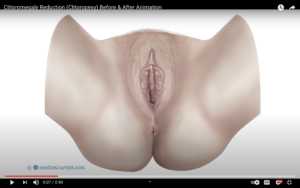Clitoropexy vs Clitoral Hood Reduction: Know The Difference
Posted by ALVR | January 20, 2021
Back to All
At ALVR, we offer a range of treatments and procedures that address a variety of vaginal conditions and concerns. We understand that pelvic anatomy and terminology can seem a little intimidating to many people, which is why we take extra care to provide our patients with all of the information they need to make the decisions that are best for them. Your body is complicated (we spent years in school learning this stuff) but we can provide some clarity on one area: the clitoris.
Generally speaking, each procedure we offer addresses a specific area of the vaginal or pelvic region: labiaplasty addresses the labia minora, monsplasty addresses the mons pubis, etc. With this in mind, it shouldn’t come as any surprise that we also offer ways of addressing concerns with the clitoris and clitoral hood.
Understanding Clitoropexy
Clitoropexy is a procedure in which the clitoris is “elevated” and is usually recommended for women who are experiencing some degree of clitoromegaly, an enlargement of the erectile tissue of the clitoris. This condition is increasingly common as more women are utilizing testosterone replacement and hormone therapy to treat symptoms of menopause, which have a direct effect on the erectile tissue of the clitoris.
Women with clitoromegaly may notice the erectile tissue of the clitoris protruding from the clitoral hood, or that the clitoris and clitoral hood area are elongated. By elevating the clitoral tissue, the overall clitoral hood length is reduced, as is the protrusion of the clitoris itself. Note that this procedure has no effect on the function of the erectile tissue itself. Clitoropexy is often combined with labiaplasty and other vaginal rejuvenation procedures.
Click the image below to watch an animated video of a clitoropexy before and after:
Understanding Clitoral Hood Reduction
A clitoral hood reduction involves removing or reducing the excess tissue and folds of skin that are present around the clitoris, creating a smoother and more aesthetic appearance. This procedure typically appeals to women who feel that they have an unsightly amount of tissue at the top of the vagina and/or find that clitoral stimulation is difficult as a result of said excess tissue. This procedure does not address enlarged or oversized clitoris from testosterone use (that’s an entirely different subject).
While reducing this tissue allows for easier exposure of the clitoris and can increase sexual stimulation, we are also careful to avoid overexposing the clitoris in the process. A clitoral hood reduction is typically performed in tandem with a labiaplasty due to the fact that the labia minora and clitoral hood comprise most of the tissue surrounding the vaginal opening, and reducing one without reducing the other can lead to an unnatural appearance.
If you are interested in learning more about these procedures or other treatments offered by ALVR, we encourage you to schedule a free consultation with us today.
Not Happy With Your Labiaplasty Results?
Not Happy with Your Labiaplasty Results? Labiaplasty Revision Might be for You Labiaplasty is a highly personal procedure that can deliver transformative results for women seeking increased comfort, confidence, and aesthetics. However, like any surgical procedure, it doesn’t always turn […]
02/11/2025 | Read More...
Looking for an Austin Labiaplasty?
Treat Yourself This Holiday Season With the Help of Austin Labiaplasty Experts Around this time of year, we’re all checking off our holiday gift lists but what about a gift to yourself? If you’ve ever considered labiaplasty or vaginal rejuvenation, […]
11/22/2024 | Read More...
Why Does My Clit Hurt?
It’s not uncommon to have a little discomfort in our private parts, but, many women often wonder why! The clitoris is home to 10,000 nerve endings, which makes it very sensitive during sexual activity and arousal. Sometimes, due to a […]
05/21/2024 | Read More...
Before & After
See how labiaplasty and vaginal rejuvenation work. Get all our photos in one document by entering your email.
Ask Us Anything
Have your labiaplasty done by one of the top rated surgeons on RealSelf. Visit Austin Labiaplasty and Vaginal Rejuvenation today.
